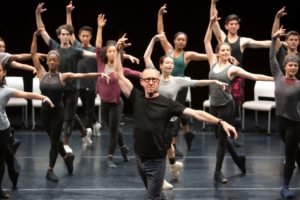
By Michael Crabb
William Forsythe once memorably stated: “If dance only does what we assume it can do, it will expire.” Forsythe, who turns 70 on December 30, has spent the better part of his career ensuring that does not happen. He did not set out to be a revolutionary, but the effect of his relentless investigations into how movement can be organized in time and space has permanently altered the way we think about what dance is and can be.
Like most theatrical art forms, dance has evolved through a natural process of imitation and elaboration as succeeding generations have built on the achievements of their predecessors. Now and then, however, someone emerges to challenge the foundational assumptions that support this evolution. William Forsythe, spurred by his interest in postmodern deconstructionist theory, is one such person. As with comparable luminaries such as Pina Bausch and Merce Cunningham, Forsythe’s broad artistic explorations have influenced other fields — architecture, film, music and the visual arts.
Forsythe, a New Yorker by birth and a musical prodigy, only began serious dance training in college. He performed with Joffrey Ballet II before leaving in 1973 for Stuttgart Ballet, a creative hothouse where Forsythe soon emerged as a promising choreographer. Although he did not formally leave Stuttgart until 1980, he was increasingly in demand as a freelance choreographer and, in 1984, was invited to head the city-sponsored Frankfurt Ballet.
For the next 20 years, while occasionally venturing out to choreograph elsewhere, Frankfurt Ballet became his creative laboratory. With a devoted ensemble of dancers, Forsythe increasingly challenged the conventions and tropes of classical ballet, not because he disdained the classical heritage, but because his curiosity about its possibilities propelled him forward.
Forsythe’s improvisational techniques allowed him to explore the potential of the human body in motion, its capacity for speed, how far its limbs could be extended and angled, be pushed off-centre or rapidly change direction. Forsythe, mischievously perhaps, undermined audiences’ expectation of art to clearly “mean” something. There was no obvious logic to his choreographic geometry and audiences were often bombarded with more information than even the quickest-witted could absorb. Curtains might rise or fall for no apparent reason. Interestingly busy dancers might be relegated to gloomily obscure parts of the stage. They might speak to each other or unexpectedly switch from full-on performance mode to casual everyday movement. While he sometimes entered into physical conversation with the music, Forsythe more often favoured electronic soundscapes, aural backdrops that created tension or mood without directing the steps. Gender norms were flouted. Forsythe’s powerful deployment of pointe work upended notions of ethereality. It projected a physical manifestation of gender equality that had moral force.
These characteristics could nowadays almost be called commonplace in contemporary ballet, but only because Forsythe has been trailed by so many imitators — most of them pale.
While North America, particularly the U.S., remained coolly sceptical about Forsythe’s experimentations, he and his company became superstars of the European dance scene. Dancers, including many from North America, vied for the chance to be part of Forsythe’s exciting vision. Among several Canadians who succeeded were Crystal Pite, now a choreographic star in her own right, and Emily Molnar who, having resurrected Ballet BC, will next August become artistic director of Nederlands Dans Theater.
As Forsythe’s work became increasingly abstruse and less audience-friendly in the eyes of Frankfurt’s cultural czars, the purse holders began to balk at the cost of supporting it. The dance world’s scandalized reaction seemed to offer the promise of a reprieve, but in the face of such civic opposition Forsythe chose to move on. The company he had nurtured for two decades gave its final performance in 2004. He gathered as many of his former dancers as possible and established a new, smaller troupe of his own, Forsythe Ballet, based in Frankfurt and Dresden. This move unleashed some of his most experimental work, the kind rarely seen in North America — although a limited budget could no longer accommodate the use of prohibitively expensive pointe shoes.
Running a company is a burden that can thwart the creative impulse and, in 2015, Forsythe relinquished his German company, passing it on to Italian choreographer and former Ballet Frankfurt member Jacopo Godani, with the remit to follow his own course. The troupe is now called the Dresden Frankfurt Dance Company.
Forsythe, the father of three children and an equal number of grandchildren, resettled in his native land, in Vermont. He spends several weeks a year in California teaching at USC’s Glorya Kaufman School of Dance.
“I have projects I’m interested in doing. It’s a matter of finding the appropriate place to do them,” says Forsythe. One of these is likely to be Boston Ballet where artistic director Mikko Nissinen, a huge admirer, is determined to build on the company’s existing body of Forsythe works.
As a disarmingly youthful septuagenarian, Forsythe’s creative career is far from done. It is unlikely he will stop asking “What if?” any time soon.
Originally published as Michael Crabb’s Notebook
DI WINTER 2019

Photo: Rose Eichenbaum/USC Kaufman
